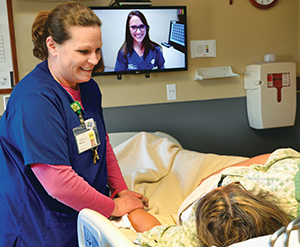By KATHLEEN NELSON
Catholic Health Initiatives is expanding and patenting a model of nursing care designed to increase individualized attention for patients by dividing, conquering and virtualizing.
CHI recently received a $1.45 million grant from the Department of Health and Human Services to expand its Virtually Integrated Care Team. Launched at CHI Health St. Elizabeth in Lincoln, Neb., the pilot program uses virtual technology and redefines nursing roles in acute care. CHI will use the grant to expand the model to more beds in adult inpatient units at St. Elizabeth and to CHI Health Good Samaritan in Kearney, Neb., in 2016. The pilot team will gather data for the next three years, comparing patient outcomes and satisfaction scores to the care received in units with traditional set-ups. CHI has applied for a patent on its concept of "Virtually Integrated Care."

Sanford
The new model emerged from discussions headed by Kathleen Sanford, CHI's senior vice president and chief nursing officer, whose team looked at ways to improve patient satisfaction de-spite a projected shortage of nurses. The team focused on the need for nurses to respond more quickly and completely to patients. Tending to the needs of several patients simultaneously leads to interruptions, about one every five minutes, according to Sanford, a situation which can frustrate patients and nurses alike.
Radical redesign
"We pretty much have done things the same way with tiny tinkering but were expecting big results," she said. "So, we said, 'Let's look at developing the team differently and dividing the work and figure out if technology can help.'"
Sanford said the group decided to jettison the traditional nurse staffing and duty model, in favor of an approach that incorporates virtual technology, "not because we're in love with technology, but to make technology work for people and make the patient experience better."

Melissa Oates, left, a registered nurse, and Jess Rowell, a virtual nurse on screen, consult with a patient in a pilot program at CHI Health St. Elizabeth in Lincoln, Neb., called the Virtually Integrated Care Team.
The model includes a team headed by a virtual nurse leader who works off the floor, away from the duties and potential distractions of a unit. The nurse leader, who holds a master's degree in nursing, coordinates and manages patient care. The nurse leader also connects directly with the patient, and vice versa, by using a two-way camera. He or she appears on a screen in the patient's room and is available to answer patient's questions or to virtually join and consult with the doctor on rounds.
Speedy response
A virtual nurse monitors up to 12 patients at a time and acts as a resource to all members of the care team. Among the virtual nurse's duties: helping with discharge planning, notifying physicians of labs and tests results, monitoring the diagnostics and vital signs, and using this information as well as the patient condition to mentor and coach the floor nurses.
Working with the virtual nurse are technicians, responsible for administering IVs and drawing blood, for example; and floor nurses, responsible for the patient's comfort, safety, well-being and administering medications.
Developers of the model say the division of tasks is more clear-cut than in traditional setups. Sue Schuelke, virtual nurse project coordinator at St. Elizabeth's, said of the new model, "Nurses are interrupted less and can focus on the patient instead of having to do the behind-the-scenes computer work that the virtual nurse can do."
Schuelke offered this example: A patient hits a call button, which activates the camera in his room and alerts the virtual nurse, who calls up the patient's electronic medical record and can answer questions or call staff on the floor, as necessary.
"It's a lot quicker for a virtual nurse to respond to a light than someone who is 10 rooms down the hall and has to wash in or wash out or finish putting in a Foley (catheter)," Schuelke said. "The virtual nurse's response time is the flick of a switch, where a traditional floor nurse would have to finish what he or she is doing."
Because the program started small, the staff reports that they had little trouble finding enough patients who were amenable to trying the technology and staffing model. Early results were encouraging. CHI's survey of patients who have participated reported a 98 percent satisfaction rate.
The team working on the model initially encountered pushback from some doctors, though Nicole Livermore, one of the first people trained as a virtual nurse leader, said the few who expressed concerns have changed their minds.
Increased individualized interaction
Planning began in late 2013; Sanford's model earned initial funding through CHI's Institute for Research and Innovation. The first bed with a camera and virtual nurse went live in May 2014 at St. Elizabeth. What set this model apart from other virtual systems, according to participants in CHI's program, is the level of back-and-forth between virtual nurse and patient.
"Many programs out there are surveillance. Ours is interactive nursing care," said Libby Raetz, vice president of patient care services at St. Elizabeth. The virtual nurse "can do the admission, monitor the chart, answer patient questions and offer education to the patient and family. The virtual nurse is part of the whole process."
Raetz added that the new model has not changed the nurse-staffing ratio in the unit. From one bed, the program has expanded to a dozen in the medical, oncology and surgical unit, and three people have been trained as virtual nurse leaders.
Livermore said the pilot program sought out people "who were gung ho about technology," clinicians who want to pioneer approaches to medical care. She helped set up the St. Elizabeth's unit and now manages it. "We also used some existing staff because of consolidation and because some were a good fit."
Refinements and expansion
The HHS grant will be used to expand the model to 20 beds in the Adult Inpatient Unit at St. Elizabeth, a 260-bed hospital, and 24 beds at Good Samaritan, a 268-bed facility.
Schuelke said CHI will compare care outcomes, patient satisfaction, length of stay, efficiency in the discharge process, and levels of secondary infections in the pilot program to other nursing units in the CHI system.
"The data will tell us what to do," she said.
The pilot team continues to refine the job descriptions and requirements of members of the Virtually Integrated Care Team. The virtual nurse leader, for example, must hold a master's degree. To that end, CHI has formed a partnership with Creighton University in Omaha, Neb., offering all expenses paid for nurses who want to earn the degree.
Raetz said those running the pilot are still testing and defining job divisions and qualifications. The role of technician, for example, could be filled by a certified nurse assistant. "Or do we look at LPNs? What is the right mix?" Raetz asked.
For true believers like Livermore, the answers will lead forward, away from the traditional model of nursing care and staffing.
"It would be very difficult to go back to the way we used to do things," she said, adding that as the virtual nurse leader, "I could really make a connection with patients. I felt they depended on me. I was more readily available in the moment. I loved developing a plan for the patient. They knew what the plan was when they left the hospital. It was comforting for them. And that's what's most important."
Copyright © 2015 by the Catholic Health Association of the United States
For reprint permission, contact Betty Crosby or call (314) 253-3477.